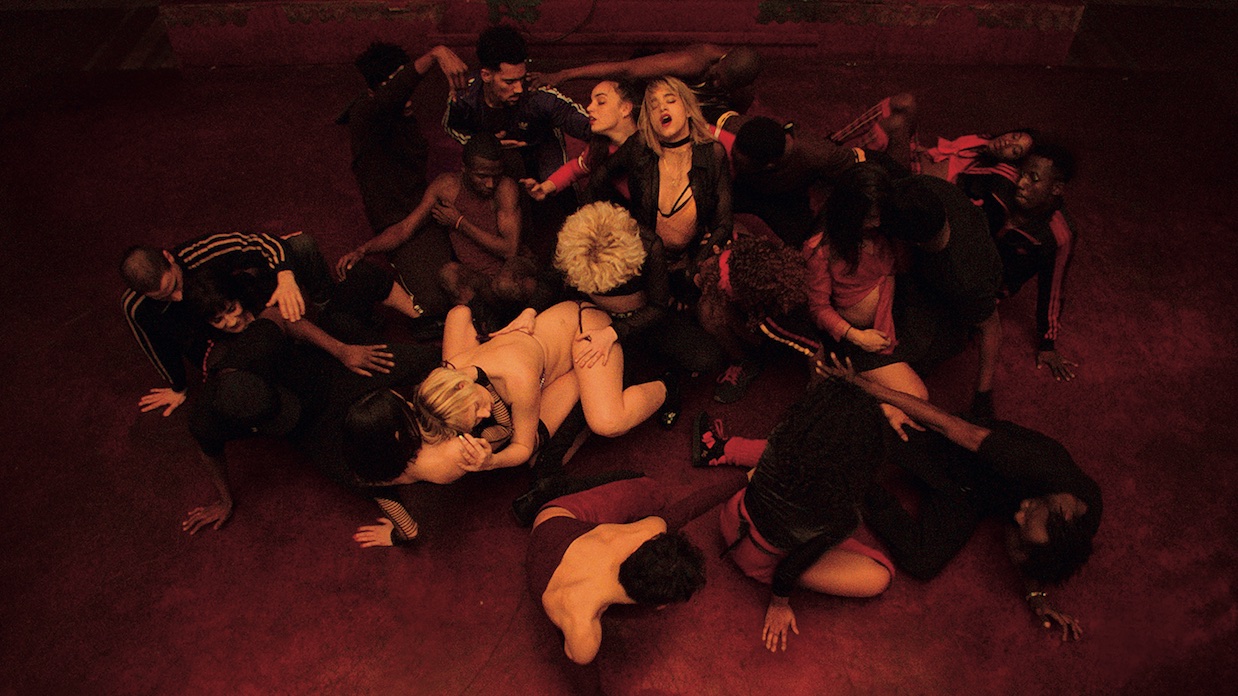 Back to selection
Back to selection
Cannes Dispatch #7: Climax
 Climax
Climax In a genuinely shocking turn of events, self-promoting shit-stirrer Gaspar Noé’s new film Climax — re-screened for festival-goers yesterday after it won the Directors’ Fortnight’s Art Cinema Award — is one of the best and most broadly-loved films to premiere in Cannes this year, pleasing devoted followers while winning over a fair many skeptics in the process. I’ll confess to being reasonably on board with his let’s-not-call-it-a-“project” coming into this one — especially when he works in 3D, as he did in his throwback to ’70s erotica, Love (2015) — though my enthusiasm for his movies has been invariably mitigated by the vapidity of their conceits and his penchant for making a fucking fool of himself in every social and ideological register. I’ve sometimes entertained the possibility that his disagreeable decisions are presented in order to challenge and complicate viewers’ abilities to connect with this work’s more expressive and sensorial pleasures — elements much better suited to his talents. But Noé is, on the other hand, a major figure of the unofficial New French Extremity brigade, so I’m more inclined to believe that he simply wants to piss people off by whatever means necessary — perhaps the only thing I’d say he consistently does well.
Climax perhaps feels like a more successful venture for Noé because it’s relatively light on these more egregious and problematic notes, thus allowing sensation to take center stage. The film is set in 1996 — peak years for electronic musicians like Daft Punk and Aphex Twin — and attends to nearly two dozen aspiring French dancers who long to join a troupe that will soon tour across France and North America. We meet them all in an extended prologue — naturally presented after the film’s closing credits scroll, which “glitches” to the beginning of the movie as an apparent call-back to Irreversible (2002) — as we watch excerpts from their audition tapes, wherein they mostly speak, for some reason, about their sexuality and experience (or lack thereof) with narcotics. Always one to cite his influences, Noé presents these clips as re-photographed off of a color CRT television screen that’s bookended by stacks of books and VHS tapes (from memory: Harakiri [1962], The Mother and the Whore [1973], Salò [1975], Zombie [1979], Possession [1981], Querelle [1982] — staples of any self-respecting transgressive, mid-’90s cinephile’s diet).
After the tapes, Climax cuts to what is supposed to be an audition party, launching into what will be a long, innervating drive into what some might call pure ecstasy (others, l’enfer) initiated by a mysteriously spiked batch of sangria — a deep dive that’s interrupted only once, still early on, for another get-to-know-you segment. (This one navigates through dozens of dialogue snatches, which are included not so much for characterization as they are to make clear that desire, a quest for experiences beyond the rational, beyond the goal-oriented, holds primacy in this arena of bodies and beats.) When it’s really going, though, this is a rapturous, euphoric film, sitting somewhere between peak Philippe Grandrieux, the Step Up franchise (though not the 3D ones, to my chagrin), and, well, every other Gaspar Noé picture. Bodies spastically, urgently contort as though compelled to lunge outside of themselves, contained by flesh and skin and gravity, which all becomes felt — by and in us — by sight. Climax may not be a great dance movie, but it is a great body movie, obsessed as it is with bodies endeavoring to be plural rather than singular, to somehow materially dissolve and blend into the matter that surrounds them.
Beyond energy, Climax is also a great film about presence — to be “here”, but also to be “now” — which is curious given that it’s a period piece set 22 years ago. It’s a movie on the verge of a new, unknowable millennium (which didn’t quite yet connote apocalyptic prognoses), of complete awareness and complete forgotten-ness—of letting go of what it means to be human, alive, capable of dying. It’s a movie that revels in the present as the only thing that can escape the future, and therefore mortality — the indisputable brevity of being here now, not yet lost to oblivion. It’s a movie that, in placing less emphasis on character, plot, and intention, harnesses the absence of substance (thanks to the help, ironically, of substance abuse) in order to showcase and celebrate a style — of cinema, of dance, of being in the world — that never stops moving. When the movie ultimately turns to violence, it does so as a means for transferring its/our state into something even more liminal. Morality is present, but weighted equally to intoxication. Noé continues, plunging us deeper into abjection — that space between our subjectivity and the objectivity of everything else, between insides and outsides, between life and death — and the film ends up reaching, or at least approaching a state where it can’t even decide itself who is fucking and who is dying — the camera, now upside down, even loses its own bearings on gravity and horizons. It’s a monumentally liberating film, and so what if it offers us nothing other than the pleasure of being entirely there with it for the time it’s in front of us.
